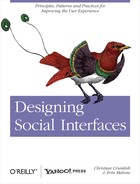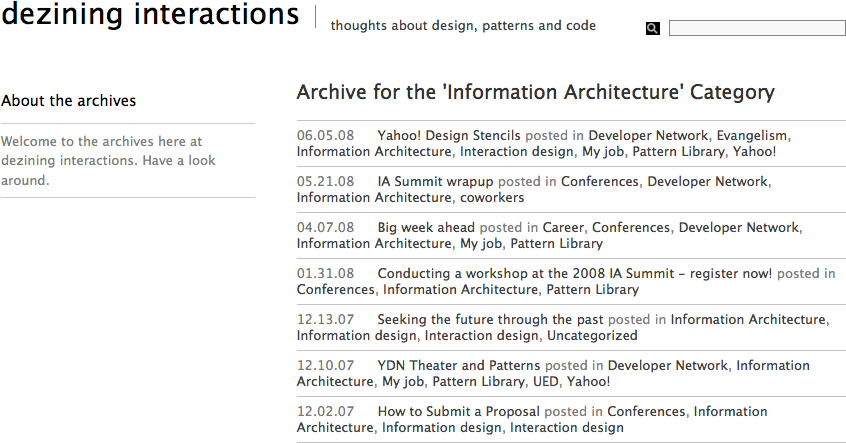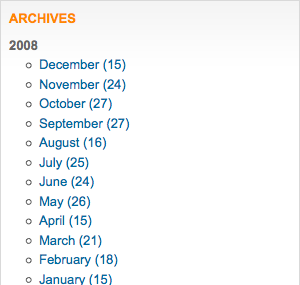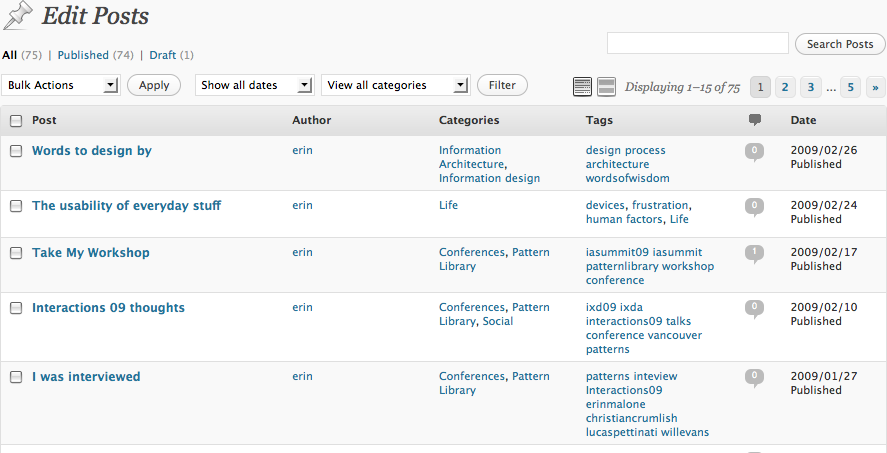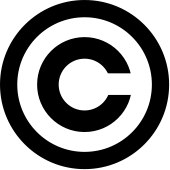Chapter 9. The Megalophone
It is in vain to say human beings ought to be satisfied with tranquillity: they must have action; and they will make it if they cannot find it.
Keeping up with friends is the viral part of what keeps the social web growing, but it is the sites with intense activity around a topic that keep people coming back over and over again, and this activity often provides the core around which these communities are built. It’s the there, there.
Destinations where people are contributing and conversing about something are often harder to define and design, because the structure and the content are defined and created by the users. This is the place where people stand on their soap boxes and inspire dialogues and arguments, and it is the place where private conversations, secrets, and intense debates can happen around subjects people are intensely passionate about.
The key is to design flexible frameworks and spaces for people to define their own sense of place. Blogs have been successful over the years because the tools out there allowed users to customize everything—the look, how often to publish, how long or short a post, how many authors or categories—while still displaying a standard suite of meta information. Pretty much everything is open, and because of that the variety of blogs and uses of blogging software are as varied as the number of people out there.
There are some emergent display patterns for blogs, forums, email, chat, and instant messages, and following these enables users to understand the type of content and the implied expectations of behavior relating to it.
Team up one or more of these broadcasting patterns with patterns such as Sign-up or Registration (Chapter 3), “Identity” (Chapter 4), Identity Cards or Contact Cards (Chapter 4), “Reputation Influences Behavior” (Chapter 6), “Ratings (Stars or 1-5)” (Chapter 10), “Comments” (Chapter 10), and “Adding Friends” (Chapter 14), to fully round out these tools.
Broadcasting
The patterns in this section give people the tools to broadcast in a one-to-many form through methods such as blogs and microblogs. Posting photos, videos, and podcasts also falls in this category and is often associated with Microblogging and Activity Streams (Chapter 5). In addition, publishing tools like licenses, rights, and Terms of Service (which cover the contracts between your site and the user who is broadcasting, and between the user and his audience of readers) are covered in detail.
Blogs: Presentation
A user wants to read commentary and view events, images, and videos on a regular basis by a particular author (Figure 9-1).
Use this pattern to bring a more casual level of commentary to readers as a complement to more formal editorial content.
Combine this pattern with Comments in Comments and Tagging in Tagging to encourage reader participation and conversations.
Combine this pattern with Hosted Modules in Hosted Modules to encourage the readership community members to interact.
How
Blogs have been around long enough to have settled into both a common format for individual posts and aggregation of the posts. Despite the advanced capabilities of common blogging software, readers have come to recognize blogs by their presentation pattern.
Posts
The individual blog post should contain these fundamentals:
Title or headline.
Content (this is the main content of the posting).
Short description. This can be an abstract extracted from the main content post, or a separate field can be provided to allow the author to write a separate abstract.
Datestamp.
Timestamp.
Author attribution. This is especially important if your site has multiple blog authors (see Attribution in Attribution).
Tags or keywords. Allow the author to pretag the post.
Comments. Most blogs have an option that allows readers to leave comments on a post. When comments are enabled, the number of comments for the post should be displayed and should be linked to the comments. The Comment link is the call to action linking to the comment form.
When comments are enabled, there should also be tools available for managing spam. A common option is holding comments for review, which allows the moderator or blog owner to delete spam before approving comments for publication. Recent years have seen the creation of antispam technology such as Akismet, which provides an API to developers that prefilters spam.
Permalink. This is the permanent link for the posting that will allow someone to bookmark the entry or blog about it.
Presentation of posts
Present posts in reverse chronology.
Allow the option for presenting posts on an index page with a title and short description for each that links off to the full post.
Provide the ability to have a single page for each individual post.
Provide the ability for a user to navigate backward and forward from one post to the next. Clearly indicate whether the user is going back in time.
Archive past posts. Allow archiving by date, tag, keyword, or category (Figure 9-2 and Figure 9-3).
Provide a search capability that searches titles, content, and tags.
Allow users to subscribe to an RSS feed of the blog. Consider allowing users to subscribe to a specific category or tag.
Provide an About area or page for author information. Information about the author lends credibility to the blog.
Unless the blog is private, allow posts to be crawled by search engines.
Why
Blogs have been around for many years now and are a core part of both personal and corporate websites. They allow informal announcements and commentary on topics of interest to the authors. Blogs that have comments and tagging enabled allow sites to build a two-way relationship with their readers.
Related patterns
Statuscasting in Statuscasting
As seen on
Blogger (http://www.blogger.com)
Dezining interactions (http://www.emdezine.com/dezininginteractions)
Six Apart (http://sixapart.com)
Wake Up (http://xianlandia.com)
WordPress (http://www.wordpress.com)
Yahoo! Developer Network (http://developer.yahoo.com)
Blogs: Ownership
A user wants to write commentary and post events, images, and videos on a regular basis (Figure 9-4).
Use when
Use this pattern to create the framework that allows users to publish text, links, images, and/or video on a regular basis.
How
Provide the author with the capability to record his thoughts, commentary, interesting links, photos, and other material.
Allow the user to customize the template of the blog presentation.
Provide a field for a title.
Provide a large enough text entry for the body of the blog post. Consider rich-text editing tools to allow the author to format a post without having to know HTML.
Allow the author to preview before publishing.
Allow the author to add tags or categories before publishing.
Consider allowing the author to schedule the publication of the blog posting into the future (Figure 9-5). This allows an author to write a series of posts at one time and then have those posts autopublish on a predetermined schedule.
Allow the author to bring in other modules of relevant content and material from other places. This might be badges from photo or link collection sites or a network of relevant relationships.
Provide the ability to upload and post photos and videos as well as text.
Give authors a dashboard to view all previous posts with a clear ability to edit (Figure 9-6).
Allow authors to go back into older posts and edit or update them. Consider providing an automatic mechanism for indicating on the main page and in the index and archives list that the post has been updated without moving the post in the time stream.
Allow authors to delete posts.
Give authors the ability to turn comments on and off for each post.
Provide authors with tools for moderating comments and comment spam (Figure 9-7).
Allow the blog owner to add authors.
Why
Light blogging tools can make blogging easier. More sophisticated and powerful tools put the ownership of managing the system (as well as the output) on the author. People will gravitate to the level of tool that is appropriate—whether it’s a hosted service, an embedded tool in a social network, or a fully owned piece of software sitting on the user’s server. Regardless, there is a base set of functionality that is now expected in blogging tools.
Giving people rich tools to share their thoughts and viewpoints is powerful. Even if only five people read it, everyone has something to say, and for every person saying something, there are a few who will listen and respond.
Related patterns
Blogs: Presentation in Blogs: Presentation
Statuscasting in Statuscasting
As seen on
Blogger (http://www.blogger.com/)
Six Apart (http://sixapart.com)
WordPress (http://www.wordpress.com)
Microblogging
Microblogging allows users to create short posts, and this type of blogging has surfaced in services such as Twitter, Yammer, and even on Facebook’s home page. These are often aggregated into a stream and can consist of text, pictures, or video (see Microblogging in Microblogging for full details).
Publishing
As people move into the role of content creator and publisher, it is important to make sure they understand the range of rights and licenses that might restrict their publishing activities. This next suite of patterns covers areas such as the Terms of Service under which people contribute and participate on some sites, and discusses copyright and the Creative Commons licenses content creators can grant others who may want to use their content.
Lifecycle
A person wants to know when something happened (Figure 9-8).
Use when
Use to give users an indication of when an item, a thought, or a conversation was added to the site.
Use to distinguish a flow between two people.
Use to indicate the freshness of an item, especially if highlighted.
How
Indicate in the metadata of the item—photo, blog post, forum post, or an item in a conversation environment such as IM or Twitter—a time- and/or datestamp (Figure 9-9).
Allow users to search or browse by date. For blog posts, provide an archive by month and year in addition to categories or tags.
Freshness
Show items by newest item first as a default (Figure 9-10).
Some sites, such as Twitter, show followers by the date the user was first followed. This is not necessarily the best organization for this type of data. This may be interesting information, but makes it difficult to easily find a specific person. There are no filters available to resort the follower list by alphabet, which would be more useful when looking for a specific person to message.
Think about whether it makes sense to sort the information or post type by date as a default.
Vitality
Use a vitality or activity stream to showcase an active community. This can be a good incentive for encouraging participation (see Activity Streams in Activity Streams).
Related patterns
Activity Streams in Activity Streams
Mobile and Location in Mobile and Location
As seen on
Facebook (http://www.facebook.com)
Flickr (http://www.flickr.com)
Twitter (http://www.twitter.com)
Rights
Before asking people to work together, work for you, or assign work to one another, it’s best to choose a model for how rights are going to be handled. It’s a matter of some ethical urgency to delineate and preserve people’s individual rights as well as to create a frame-work of rights that fosters a climate of creativity and additive collaboration. It’s equally important to educate participants so that they fully understand what rights they retain, what rights they give up, and what rights they must respect before rolling up their sleeves and getting to work (Figure 9-11).
When inviting people to contribute content to your website, ask them to verify that they have the right to do so before they become active contributors.
See Terms of Service in Terms of Service for advice on how to inform participants and to learn about the different license models you might consider for contributed content.
Terms of Service
A Terms of Service Agreement provides a legal framework for the use and dissemina-tion of “information services” and intellectual property assets provided on a website. (See Figure 9-12.)
Every website can be construed as a provider of “information services” to the consumers of this information, whether it is visitors or registered members. Although it is not necessary to have a Terms of Service Agreement on a website, it serves as a legal safeguard that establishes roles and responsibility for creation, use, and redistribution/dissemination of intellectual property in the event of a dispute or legal action.
When a form includes a checkbox for the user to indicate agreement to the Terms of Service (TOS), the user often doesn’t notice the checkbox and is confronted with an error message and a demand to read and agree to them before completing the form. There’s no reason to place the user in this position, where she may feel affronted merely because she did not notice a checkbox.
Use when
Use this pattern in check-out flows and sign-up forms (Figure 9-13).
Use this pattern when allowing users to create original content that will be publicly hosted on your service.
How
Consent to the agreement is expressed in the call-to-action button (“Agree and Continue”).
The form offers an option to exit without agreeing (“Cancel” or “Don’t Agree/Cancel Order”).
A statement makes it clear that submitting the form constitutes agreement to the terms (“By clicking you agree...”).
The TOS text is available via a clearly labeled hypertext link (Terms of Service).
The TOS copy is supplied in a printable format.
Internationalization
In different international regions, laws may require a separate checkbox or an interstitial that forces the user to see the TOS before continuing.
Why
The goal of this pattern is to make the experience of completing the form better for the user and to avoid interrupting her or making her feel as though she has made an error.
Combining the agreement with the call-to-action button and clearly labeling the option offers a streamlined experience in the natural flow of filling out the form. The experience is somewhat analogous to signing a document.
It is important to offer an option to exit (cancel) the form without making the agreement, giving the user an escape hatch and making her consent to the terms meaningful, given that she had an alternate choice available.
Linking to the TOS provides direct access to the legal copy but avoids cluttering the page with either a large amount of verbiage or an embedded text box or iframe.
The language preceding the buttons clearly explains that clicking means agreeing, so the legal force of the agreement is clear.
Offering a printable TOS is a best practice that enables the user to keep a copy of what she agreed to (or an opportunity to show it to a legal expert before agreeing).
These five elements of the pattern work in tandem. Removing any one defeats the purpose of the pattern.
Finally, this pattern represents a best practice in the industry, and is used by companies for whom check-out flows are core experiences (such as PayPal).
Sources
Terms of Service in the Yahoo! Pattern Library, http://developer.yahoo.com/ypatterns/social/people/engagement/tos.html
As seen on
eBay (http://ebay.com)
PayPal (http://paypal.com)
Yahoo! HotJobs advertiser interface (http://hotjobs.yahoo.com/)
Licenses
The licensing regime you offer your users (whether it’s a single type of license or a range of options) may have a profound effect on the sorts of collaborations that can ensue. If people are unsure about their legal rights, worried about losing their rights, or (worse yet) afraid of being charged with infringing on the rights of others, ordinary risk-aversion will tend to decrease the amount of participation.
There are ethical implications for any system of licenses, but the considerations are many. We don’t necessarily suggest that you follow any specific regime, but here are some of the most common in use online:
- Public Domain
The most liberal. Some content eventually will enter the public domain, even when originally given a tighter license.
- Creative Commons
A nuanced range of choices designed to give options encouraging reuse.
- Copyleft
An un-copyright regime invented by hackers.
- Copyright
Traditional government-enforced copyright, which has become imbalanced in favor of original creators and against the public domain.
Public Domain
Public Domain licensing is the most liberal available (Figure 9-14).
From Wikipedia:
The public domain is a range of abstract materials—commonly referred to as intellectual property—which are not owned or controlled by anyone. The term indicates that these materials are therefore “public property”, and available for anyone to use for any purpose. The public domain can be defined in contrast to several forms of intellectual property; the public domain in contrast to copyrighted works is different from the public domain in contrast to trademarks or patented works. Furthermore, the laws of various countries define the scope of the public domain differently, making it necessary to specify which jurisdiction’s public domain is being discussed.
From Wikipedia’s article on public domain licensing at Wikipedia itself:
For all practical purposes on Wikipedia, the public domain comprises copyright-free works: anyone can use them in any way and for any purpose. Proper attribution to the author or source of a work, even if it is in the public domain, is still required to avoid plagiarism.
The public domain is generally defined (e.g., by the U.S. Copyright Office) as the sum of works that are not copyrighted, i.e., that were not eligible for copyright in the first place, or whose copyright has expired.
However, there is no such thing as the public domain on the Internet. International treaties, like the Berne Convention, are not self-executing and do not supersede local law. There is no globally valid “International Copyright Law” that would take precedence over local laws. Instead, signatory countries of the Berne Convention have adapted their laws to comply with the minimum standards set forth by the treaty, often with stronger provisions than required. Whether or not something is copyright-free in some country depends on the laws of individual countries.
Wikipedia, and the Wikimedia Foundation, its legal body, are based in Florida, United States. Although legislation is sometimes unclear about which laws are to apply on the Internet, the primary law relevant for Wikipedia is that of the United States. For re-users of Wikipedia content, it is the laws of their respective countries.
In the U.S., any work published before January 1, 1923 anywhere in the world is in the public domain. Other countries are not bound to that 1923 date, though.
If you can get all your stakeholders (from the owner of the site to the participants) to agree to place as much content as possible in the public domain, or to make public domain licensing the default for collaborative content, then you will enable the greatest possible reuse and remixing of your community’s content, with the consequence being a giving up of control over how the content may be used or altered by others.
Creative Commons offers a public domain option (see Creative Commons in Creative Commons).
Sources
Creative Commons public domain dedication, http://creativecommons.org/licenses/publicdomain/
Ethical Public Domain, http://ethicalpublicdomain.ning.com/ Public Domain Information Project (royalty-free music), http://www.pdinfo.com/index.php
When U.S. Works Pass into the Public Domain, http://www.unc.edu/~unclng/public-d.htm
Wikipedia: Public domain, http://en.wikipedia.org/wiki/Wikipedia:Public_domain
Creative Commons
Creative Commons licenses were created to foster creative collaboration and encourage people to opt for the loosest possible restrictions while balancing that against any rights they feel they absolutely must retain (Figure 9-15). Creative Commons licenses address four conditions that may be applied:
- Attribution
Others may copy, distribute, display, and perform your copyrighted work and derivative works based on it as long as they give you credit the way you request. For example, patterns in the Yahoo! Design Pattern Library require attribution only.
- Share Alike
Others may distribute derived works based on yours, but only if they use the identical license terms.
- Noncommercial
Others may copy, distribute, display, and perform your work and derivative works based on it, but only for noncommercial purposes.
- No Derivative Works
Others may copy, distribute, display, and perform only verbatim copies of your work.
Creative Commons licenses
Based on those four conditions, there are six non-public domain CC licenses you can choose from or offer as choices for your users:
- Attribution
This license lets others distribute, remix, tweak, and build upon your work, even commercially, as long as they credit you for the original creation. This is the most accommodating of licenses offered, in terms of what others can do with your works licensed under Attribution.
- Attribution Share Alike
This license lets others remix, tweak, and build upon your work even for commercial reasons, as long as they credit you and license their new creations under the identical terms. This license is often compared to open source software licenses. All new works based on yours will carry the same license, so any derivatives will also allow commercial use.
- Attribution No Derivatives
This license allows for redistribution, commercial and noncommercial, as long as it is passed along unchanged and in whole, with credit to you.
- Attribution Noncommercial
This license lets others remix, tweak, and build upon your work noncommercially, and although their new works must also acknowledge you and be noncommercial, they don’t have to license their derivative works on the same terms.
- Attribution Noncommercial Share Alike
This license lets others remix, tweak, and build upon your work noncommercially, as long as they credit you and license their new creations under the identical terms. Others can download and redistribute your work just like the Attribution Non-Commercial No Derivatives license, but they can also translate, make remixes, and produce new stories based on your work. All new work based on yours will carry the same license, so any derivatives will also be noncommercial in nature.
- Attribution Noncommercial No Derivatives
This license is the most restrictive of the six main licenses, allowing only redistribution. This license is often called the “free advertising” license because it allows others to download your works and share them with others as long as they mention you and link back to you, but they can’t change them in any way or use them commercially.
Sources
Portions of this entry are adapted from content at the Creative Commons website (http://creativecommons.org), published under the Creative Commons Attribution License.
Copyleft
Copyleft is a play on the word “copyright” to describe the practice of using copyright law to remove restrictions on distributing copies and modified versions of a work for others and requiring that the same freedoms be preserved in modified versions (Figure 9-16).
Copyleft is a form of licensing and can be used to modify copyrights for works such as computer software, documents, music, and art. In general, copyright law allows an author to prohibit others from reproducing, adapting, or distributing copies of the author’s work. In contrast, an author may, through a copyleft licensing scheme, give every person who receives a copy of a work permission to reproduce, adapt, or distribute the work as long as any resulting copies or adaptations are also bound by the same copyleft license. A widely used and originating copyleft license is the GNU General Public License. Similar licenses are available through Creative Commons Share Alike.
Copyleft licenses are sometimes referred to as viral copyright licenses, because any works derived from a copyleft work must themselves be copyleft when distributed.
Copyleft is considered “strong” when its provisions can be imposed on derived works, and weak when not all derived works inherit the copyleft license.
Sources
Gratis vs. Libre, http://en.wikipedia.org/wiki/Gratis_versus_libre
What is Copyleft?, Free Software Foundation, http://www.fsf.org/licensing/essays/copyleft.html
Copyright
Copyright is a form of intellectual property that gives the creator of an original work exclusive rights for a certain time period after which time the work is said to enter the public domain (see Public Domain in Public Domain). These rights include publication, distribution, and adaptation. Copyright covers published and unpublished literary, scientific, and artistic works, whatever the form of expression, provided that such works are fixed in a tangible or material form.
“Copyright” literally means the right to copy.
Internationally, copyright has been somewhat standardized, lasting between 50 to 100 years from the author’s death, or a finite period for anonymous or corporate authorship, but there are no “international copyrights” that enable you to protect your work through-out the world (Figure 9-17).
Most countries are signatories of the Berne Convention and the Universal Copyright Convention (UCC), which allow you to protect your works in countries of which you are not a citizen or national. The 1886 Berne Convention first established recognition of copyrights among sovereign nations, rather than merely bilaterally. Under the Berne Convention, copyrights for creative works do not have to be asserted or declared, as they are automatically in force at creation.
“Fair use” is a doctrine in United States copyright law that allows limited use of copy-righted material without requiring permission from the rights holders, such as use for scholarship or review.
Sources
Copyright entry at Wikipedia, http://en.wikipedia.org/wiki/Copyright
U.S. Copyright Office, http://www.copyright.gov/
What is Copyright Protection?, http://www.whatiscopyright.org/
Further Reading
Blog Design Solutions, by David Powers, Phil Sherry, Andy Budd, Simon Collison, John Oxton, Richard Rutter, Chris J. Davis, and Michael Heilemann; friends of ED, 2006
Copyright FAQ, http://www.copyright.gov/help/faq/
More about Creative Commons, http://creativecommons.org/
“My 140conf Talk: Twitter as Publishing,” by Tim O’Reilly, O’Reilly Radar
